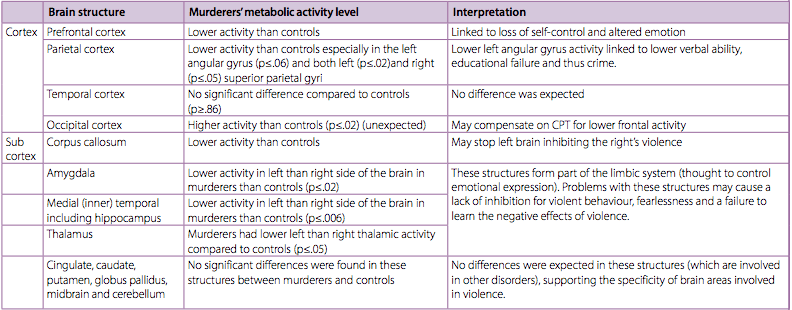Raine, A., Buchsbaum, M., & LaCasse, L. (1997). Brain abnormalities in murderers indicated by positron emission tomography. Biological psychiatry,42(6), 495-508.
Background
This is a study you may need for your OCR H567, Applied Psychology exam. It is from the criminal psychology unit. It considers the topic: What makes a criminal (biological). The application for this study is at least one biological strategy for preventing criminal behaviour.
Several previous research studies have suggested that damage to the pre-frontal cortex may cause individuals to become increased in impulsivity, immaturity. It may also caused altered emotionality, loss of self-control and the inability to modify behaviour. The combination of all of these behavioural deficits may lead to increased aggressive behaviour (Damasio, Tranel & Damasio. 1990; Weiger and Bear 1988).
Damasio et al. (1990) suggested that after damage to the pre-frontal cortex, previously normal individuals would display behaviour which would be considered abnormal and they would display deficits in decision making and planning.
Watch this video on Phineas Gage:
The amygdala is associated with aggressive behaviour and also the recognition of emotional stimuli such as a fearful expression on someone’s face.
Damage to the amygdala is associated with ‘fearlessness’. The part of the limbic system made up of the amygdala, hippocampus and prefrontal cortex governs the expression of emotion. Together with the thalamus, these areas are also important in learning, memory and attention and it has been suggested that abnormal functioning may lead to problems such as not being able to form conditioned emotional responses and the failure to learn from experiences.
Raine et al. (1997) used PET scans to gather data. In order to gain a deeper understanding of this study, learn how PET Scans work:
Watch this short video on how PET scans work:
One particular group of violent offenders are those who plead not guilty by reason of insanity (NGRI) to a charge of murder.
Raine et al. (1997) used PET scans to discover whether there are brain abnormalities in murderers who plead NGRI. If significant differences could be found between the patterns of glucose metabolism in the brains of such individuals compared to non-murderers, the correlation may indicate that murderers (pleading NGRI) are more prone to violence than non-murderers. Until this study, no previous brain imaging had been conducted to either support or refute this notion.
The hypothesis in this study by Raine et al. (1997) is that these seriously violent individuals have localised brain damage in a variety of regions: the prefrontal cortex, angular gyrus, amygdala, hippocampus, thalamus and the corpus callosum.
In a preliminary report on a pilot sample of 22 NGRI offenders compared to 22 ‘normals’, Raine et al. (1994) showed support for the idea of prefrontal dysfunction in NGRIs.
Aim
The aim of Raine et al. (1997) study was to build on previous research.
Two hypotheses were tested:
- Seriously violent individuals pleading NGRI have relatively localised brain dysfunction in the prefrontal cortex, angular gyrus, amygdala, hippocampus, thalamus and corpus callosum (areas of the brain previously linked empirically or conceptually to violence).
- Seriously violent individuals pleading NGRI show no dysfunction in other brain areas i.e. caudate, putamen, globus pallidus, midbrain, cerebellum) which have been implicated in other psychiatric conditions but which have not been related to violence.
Method and Design
Quasi Experiment.
The Independent Variable was whether the participants was a ‘normal’ non-murderer or a murderer who had plead ‘not guilty by reason of insanity’.
The dependent variable was whether the participant showed evidence of brain dysfunction in their prefrontal cortex and other areas such as the angular gyrus, amygdala, hippocampus, thalamus and corpus callosum
The experiment is considered quasi because the experimenters could not manipulate the independent variable as it was naturally occurring; a person was a murderer, or they were not a murderer.
The study used a matched participants design. Participants were matched on age and gender and the six schizophrenics in the experimental group were matched with six schizophrenic controls (‘normal’, non-murderers) who had not committed murder.
Sample and Sampling Method
Murderers
The experimental group was composed of 41 individuals (39 males and 2 females) who had been tried in California for either murder or manslaughter (These were all labelled as ‘murderers’ by the researchers). They had a mean age of 34.3.
They were referred to the University of California, Irvine (UCI) imaging centre for the following reasons:
- To obtain evidence as to whether they were NGRI.
- To find out if they were competent to understand the judicial process.
- To see if there was any evidence of diminished mental capacity which may affect the nature of the sentence they received.
They were individually referred for the following reasons:
- 6 had schizophrenia.
- 23 had head injuries or organic brain damage.
- 3 had a history of psychoactive drug abuse.
- 2 had affective disorders.
- 2 had epilepsy.
- 3 had a history of hyperactivity and learning disability.
- 2 had personality disorders (passive-aggressive or paranoid personality disorder).
Within in the preceding individuals, 7 were surrounded by unusual circumstances which suggested some mental impairment.
The control group of non-murderers was composed of 41 individuals (39 males and 2 females) were matched with the murderers by age and gender and had a mean age of 31.7 years which was considered not significantly different to the experimental group. Excluding the 6 schizophrenics in the control group, all of the control participants were screen for any history of mental illness.
The non-murderers in the sample were ‘normal’, not taking any medication, and they did not have a history of mental or medical illness. However, six non-murderers were schizophrenics. They were included in the sample because Raine et al. (1997) could match them with six schizophrenic murderers in the sample.
Materials
- Thermoplastic head holder, individually modelled / molded, to hold the participant’s head still while being scanned.
- PET machine to image brain functioning.
- Flourodeoxyglucose (FDG) tracer injected to trace brain metabolism.
- A degraded stimulus version of a continuous performance task (CPT) which required participants to detect target signals for 32 minutes, a task which had been shown to make the frontal lobes work especially hard, together with the right temporal and parietal lobes, so investigators could see how the different areas functioned.
Procedure
All the participants participated under protocols and consent forms approved by the Human Subjects Committee of University of California, Irvine.
All of the murderers were kept in custody and were medication free for two weeks prior to the brain scanning. All of the non-murderers were not taking any medication. This is a control measure.
Ten minutes before receiving the FDG injection, participants were given practice trials on the CPT. This is another control.
30 seconds before the FDG injection, participants started the actual CPT so that the initial novelty wouldn’t be FDG labelled and to get their brains ’working’. This is another control.
32 minutes after the FDG injection, the participant was transferred to an adjacent PET scanner room. An individually molded, thermosetting plastic head holder was used to hold the head still during the scan. 10 slices (pictures) at 10 mm intervals parallel to the cantheomeatal line were recorded which provided details in relation to differences in brain metabolism in both six main cortical areas (the outside of the brain) and eight sub-cortical areas (inside the brain). This detail was precise so that the study could be replicated.
The cantheometal line is a horizontal line drawn from the eye to the ear.
Results
Brain imaging results.


14 murderers were non-white, but when they were compared on PET Measures with the white control participants, there was no significant difference between them.
23 of the murderers had a history of head injury, but they showed no significant difference between non-head injured murderers except in the functioning of their corpus callosum, and the authors accepted that this may have contributed towards a reduction in the murderers’ brain activity.
No significant differences were found for performance on the CPT or handedness (except left-handed murderers had significantly less abnormal amygdala asymmetry than right-handed murderers).
Summary of Murderers results
Reduced activity (i.e. reduced glucose metabolism) in some areas, notably the areas previously linked to violence (e.g. the prefrontal cortex, left angular gyrus and corpus callosum).
Abnormal asymmetries: reduced activity on the left, greater activity on the right. This applied to some of the areas identified in the hypothesis as being linked to violence (e.g. the amygdala, thalamus and hippocampus).
No differences in some areas, notably those structures that were associated with mental illness but not violence (e.g. the caudate, putamen, midbrain and cerebellum).
Conclusions
Murderers pleading NGRI have significant differences in the metabolism of glucose in a number of brain areas compared to non-murderers.
Raine et al. (1997) identifies some specific physiological processes which may predispose some criminals to violent behaviour. Reduced activity in the prefrontal, parietal, and callosal regions of the brain, together with asymmetries of activity in the amygdala, thalamus, and medial temporal lobe including the hippocampus, may be one of many predispositions towards violence in murderers pleading not guilty by reason of insanity. This reduced activity in the prefrontal areas may explain impulsive behaviour, a loss of self-control, evidence of immaturity, altered emotionality and the inability to modify behaviour. All of these may make it easier to carry out different kinds of aggressive acts because the normal constraints on behaviour may be reduced.
The neural processes which underlie violent behaviour can’t simply be reduced to a single brain mechanism that causes violence. It seems there are several processes involved and if there are deficits in a number of these processes, the likelihood of violent behaviour occurring is much greater.
The results do NOT show that violent behaviour is determined by biology alone. There are a number of other factors which must be taken into account. Social experiences, situational factors, psychological predispositions and learned responses will all have their part to play and perhaps the physiological elements may only produce predispositions to extreme forms of violent behaviour rather than being a cause in themselves. One should therefore be cautious about attributing the reason why individuals commit murder simply to the fact that they are found to have mental disorders.
Results do NOT show that murderers pleading NGRI are not responsible for their actions, nor that PET scans can be used as a means of diagnosing violent individuals.
Results do NOT show that brain dysfunction CAUSES violence. It may even be that brain dysfunction is an effect of violence.
Results do NOT show that all violent offenders have such brain dysfunctions; the study can only draw conclusions about this kind of violent offender i.e. murderers pleading NGRI.
Violence CANNOT be explained by the results; the results relate merely to the criminal behaviour of individuals who commit murder and then plead NGRI
Raine et al. (1997) Evaluation
+ Ethics – The participants participated under protocols and consent forms approved by the Human Subjects Committee of University of California, Irvine, meaning that participants were protected from harm and gave informed consent.
+ Internal Validity – the use of a matched control group increases the internal validity of Raine et al. (1997).
– Generalisability – the participants were all from California which means it may be difficult to generalise the results to the wider population and murderers who have plead not guilty by reason of insanity in different geographic areas because there may be something specific about Californians which caused the results.
+ Predictive Validity – the statistical significance of the results and the high number of controls use in this study suggests that the results may be used to predict individuals which may be predisposed to commit murder and then plead not guilty by reason of insanity.
+ Psychology as a science – Raine et al. (1997) provides support for the debate psychology as a science. This is because it is a highly controlled, nomothetic laboratory study, which has falsifiable measures.
– Socially Sensitive Research – because this study by Raine, has used Murderers who have plead not guilty by reason of insanity, this study may be considered socially sensitive.
References
Damasio, A. R., Tranel, D., & Damasio, H. (1990). Individuals with sociopathic behavior caused by frontal damage fail to respond autonomically to social stimuli. Behavioural brain research, 41(2), 81-94.
Raine, A., Buchsbaum, M., & LaCasse, L. (1997). Brain abnormalities in murderers indicated by positron emission tomography. Biological psychiatry,42(6), 495-508.
Raine, A., Buchsbaum, M. S., Stanley, J., Lottenberg, S., Abel, L., & Stoddard, J. (1994). Selective reductions in prefrontal glucose metabolism in murderers. Biological psychiatry, 36(6), 365-373.
Weiger, W. A., & Bear, D. M. (1988). An approach to the neurology of aggression. Journal of Psychiatric Research, 22(2), 85-98.
Further Reading
Cortical Functions (Routledge Modular Psychology)
Psych Yogi’s Top Ten Psychology Revision Tips for the A* Student

